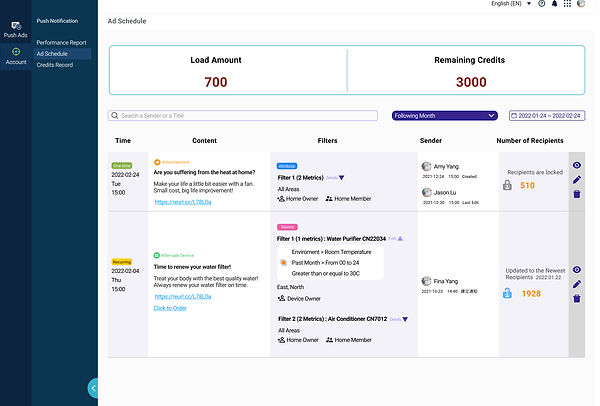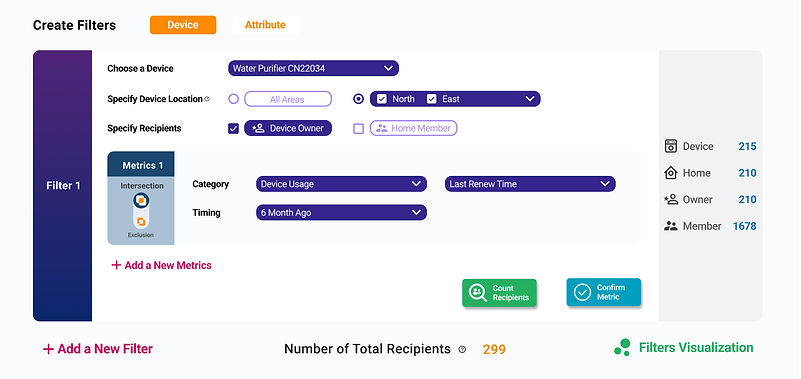UX Design Portfolio

Push Ads Creator
This is a tool for marketers to find the precise target audiences with real data, according to how they actually live.


What is the problem?
Data is the most valuable thing in the IoT industry. Through these little smart devices placed in homes, we get to learn about individual customers' everyday life to an almost intimate level.
Hence, we were looking to design an ad creator tool application that utilizes this powerful resource for precision marketing to advertise the desired audience through push notifications in our mobile app, which is primarily used for smart device control.
This ad creator tool empowers users to filter the target audiences based on the performances and conditions of IoT devices in their homes. In other words, this tool defines and tags audiences by the logs of smart appliances that they own.
Who are the users?
We are an IoT company that not only manufactures our branded IoT devices but also supplies chips and sensors to considerable household appliance brands. Through the cooperation, their products integrate into the IoT solution and become compatible with our mobile app.
For now the marketing teams of those household appliance companies are the major users of this ad creator tool, which is mainly used for consumables or new product promotions. Overall, it's easier to sell IoT products to people who are already adapted to smart homes.
What is the challenge?
The challenges of this project come from its innovation. The metrics that this tool implements have to be based on IoT data collection, which is very different from how mainstream ad creators (such as Google or Facebook) currently work. Since there aren't many public resources out there for us to take as references, the team has to figure things out on our own.
What is the solution?
I start by breaking down and segmenting all the sensor applications, types of logs, and other accessible data to see how much of the information we currently are retaining can be translated into comprehensible audience metrics and what this tool can potentially offer.
Two Metric Setting Models: Device and Attribute
To maximize flexibility while minimizing complexity, we design two models for marketers to select from based on their purposes--Device and Attribute.

The device model allows users to choose one or multiple specific products from their brand and set the metrics based on users' behaviors interacting with the devices or the environmental information the devices have collected. For example, it can sieve out smart water purifiers with outdated filters according to consumable usage sensors and push notifications to the device owners with filter promotion news.

The attribute model is established on the data from mixed sensors that our company holds, including time-related physical presence detections and digital environmental information (such as temperature, humidity, or air quality.) This is designed for finding a niche market. For example, a new dehumidifier is launching and the marketing team wants to find a group of potential buyers who are truly suffering from high humidity problems.
Level Metric Advanced Options: Intersection and Exclusion
We try to limit marketers as less as possible. Filters are unioned by default. To maximize the flexibility of metric settings, we offer each metric exclusion and Intersection options to give users a maximum level of flexibility to filter with precision.

Two Notification Types: Advertisement and After-sale Service
Sometimes a household would have more than one device that fits the metrics. Besides the flexibility of choosing device owners or house members, we also provide two different types of notifications with different definitions of recipients for users to select based on their purposes.
Briefly speaking, each recipient only will receive an advertisement notification once each time whether he/she owns multiple devices that fit the metric. Vice versa, one recipient can receive multiple after-sale service notifications if many of his/her devices are targeted.
Renew Recipients Timely or Lock Current Recipients
The conditions of devices are flowing. For any scheduled campaign, users get to choose whether to update the newest recipients before the server sends the notifications out. If not, users can click lock current recipients to preserve this group of audiences at the moment when the campaign is saved.
One-time Campaign or Recurring Campaign
This push ads creator as well enables users to repeatedly send notifications to the same targeting group to track long-term performances. Involved with gamified elements, it encourages users to make adjustments timely and accordingly in order to maintain satisfactory audience segmentation.
Product Highlights

01
Enable users to navigate at a glance
The layout of the dashboard is quite simple. Everything is on one page. Marketers should spend their effort on mapping the defined objectives into relevant metrics instead of getting lost in countless dropdowns. A very straightforward ad creation process also saves us time in educating users on how to tailor an ad campaign.
02
Visualize the Filters and Metrics
For one campaign, users can set up multiple filters and in each filter, multiple metrics can be created. In order to enhance comprehensibility, users can click Filters Visualization Button to see the visualized charts in a pop-up.


03
Value transparency
Different from most goal-driven ad creators that give out vague numbers on the campaign performance report, we inform our users of the exact numbers of notification receivers before the campaign is launched and as well allow them to track the up-to-the-minute unique open rate.
04
Involve gamified elements to evoke positive emotions
Pleasure is usually overlooked in B2B products. However, we believe keeping users entertained at work can improve job performance. The whole concept of the product is like a Lego. Users have to use filters and metrics as bricks to build a preferred campaign. We also apply gamification mechanics to the ad results report page to encourage users' efforts.
